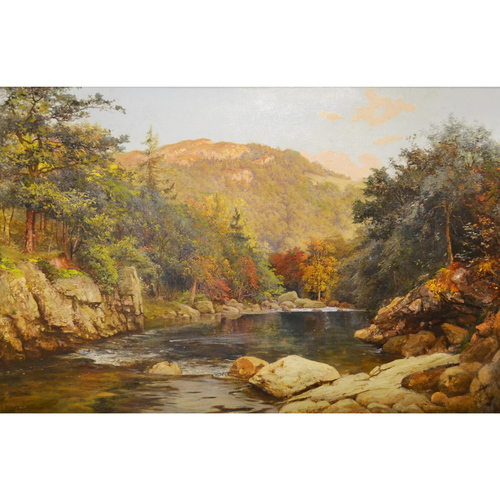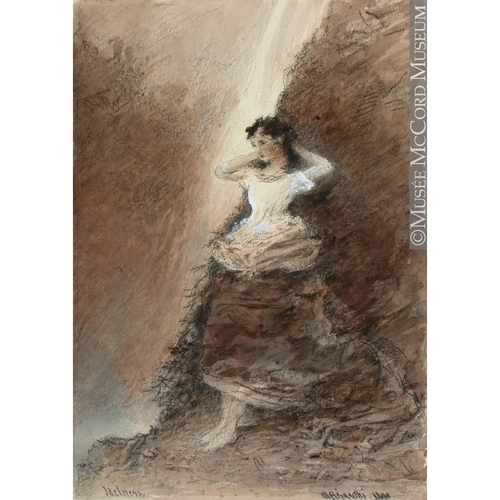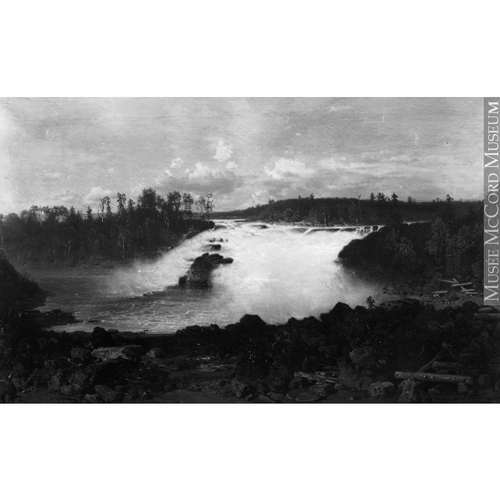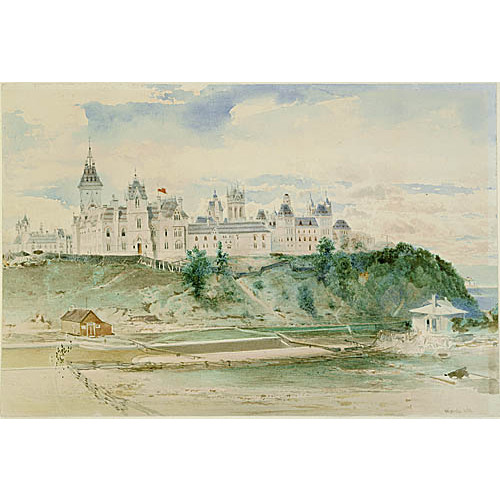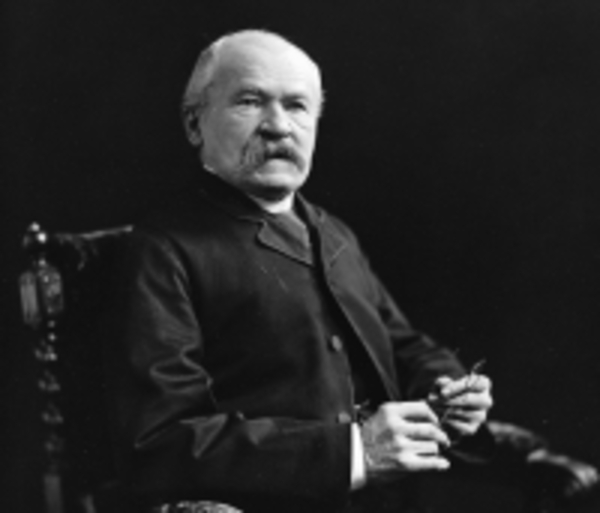
Source: Courtesy of Wikimedia Commons
JACOBI, OTTO REINHOLD, painter and teacher; b. 27 Feb. 1812 in Königsberg (Kaliningrad, Russia), son of Ehlert Reinhold Jacobi and Johanne Louise Linck; m. 1838 Sybille Reuter, and they had two sons and two daughters; d. 8 Feb. 1901 in Ardoch, N.Dak.
Otto Reinhold Jacobi was the youngest of three children of a prominent merchant and malt brewer. Showing a notable talent for art as early as age ten, by his own account he began giving private lessons after the death of his father in 1822. He received his first formal instruction in drawing from Christian Ernst Rauschke and then studied under the portraitist Andreas Knorre. At age 16 he left high school to teach in Königsberg’s institute for the deaf and dumb. Two years later, in 1830, financial support from his father’s friends permitted him to study at the Berlin Academy of Arts; he also took lessons from Karl Friedrich Schulz. That September Jacobi participated in his first exhibition. In 1832 he won a three-year stipend to attend the academy in Düsseldorf (Germany), one of Europe’s most prestigious; he later received instruction there from Johann Wilhelm Schirmer. The academy attracted students from far away and may have provided Jacobi his first contact with North America. In the nine years he spent at Düsseldorf he met the Montreal-born artist Henry Ritter and, probably, the American history painter Emanuel Gottlieb Leutze. A later biographer of Jacobi’s, William Robinson Watson, speculated that in 1855 he met the painter Cornelius Krieghoff*, who had already become established in Lower Canada.
Jacobi’s years in Düsseldorf were productive. He continued to exhibit in Berlin (1834, 1836, 1839) and also showed in Halberstadt (1836) and Leipzig (1837, 1839, 1841). A recently discovered sketchbook documents a tour he made in October 1834 of the Palatinate region, where he may have met Sybille Reuter. According to family lore he developed smallpox, and Billa, as he called her, nursed him back to health. In the year they were married, 1838, he illustrated a poem in Robert Reinick’s Lieder eines Malers, mit Randzeichnungen seiner Freunde (Songs of a painter, with border illustrations by his friends), published in Düsseldorf, and sold a landscape, a scene near Lake Geneva, to the Königsberg municipal museum. Jacobi’s portrait of Billa dressed in the costume of a Frisian fisherwoman so pleased the Prussian crown prince, then visiting Düsseldorf, that he purchased it for nearly double the requested price. Also allegedly sold, to what is now the National Gallery (Berlin), was another landscape, a winter scene on the Rhine. The couple’s first child, Ernst (Ernest) Reinhold, was born on 30 April 1839, and their second, Carl Gustav Viktor, three years later.
Jacobi’s resourcefulness led directly to his first permanent appointment. Around 1840 or 1841 the empress of Russia, a Prussian princess, visited the spas in the duchy of Nassau (Germany) and requested the duke to provide her with, in Jacobi’s words, an “Album of fine watercolours of the surroundings of Ems.” Asked to undertake the commission, he solved the problem of learning where the empress had visited (she had presumably travelled incognito) by locating her guide. The paintings Jacobi executed so pleased the dowager duchess of Nassau that she engaged him “on the spot” as court painter in Wiesbaden, the duchy’s capital. For some 20 years he taught art to the children of the ducal household, was conservator of the duke’s picture collection, and painted both for the court, including frescos for the Greek Chapel (1855), and for audiences farther afield. His dealer, Moatz Bessunger, of Liverpool, England (1853) and later Montreal (from 1855), bought his paintings by the closed crate and sold them in England and in North America. Jacobi seemed to be at the height of his career. The “very happy life” the Jacobis lived at Wiesbaden included the birth of two more children, Franziska (Francesca), in 1845, and Louise, in 1851.
Jacobi’s situation may have changed with the death in 1856 of the dowager duchess. Also, when his younger son died of typhoid fever in 1858 he was left with a sole male heir who, because he had just completed an engineering course at Karlsruhe, was an attractive candidate for military service. Moreover, in a letter written in 1896 Jacobi alluded to intrigue at court, the details of which his discretion prevented him from revealing. (In 1891 an American newspaper alleged that he had participated in revolutionary activities in 1848 and was saved from prosecution only by virtue of his position at court.) Perhaps for these reasons or simply to explore the possibility of improved prospects abroad he left Wiesbaden in 1860 and travelled on his own to New York.
Jacobi’s experience in executing commissions for royalty may have played a role in his next move. Bessunger met him in New York and brought him to Montreal that year. There, Jacobi related in an autobiographical sketch written in 1894 for author Henry James Morgan*, he was asked to do a painting of the falls at Shawinigan, near Trois-Rivières, for presentation to the Prince of Wales, who was then visiting the province of Quebec. However reassuring it is to have a primary written account of this frequently repeated story, the fact remains that no other record of this commission or of the painting itself, which Jacobi asserts gave “great satisfaction,” has survived. In Watson’s words, “The whole episode is enigmatic, and has never been fully explained.” Whatever the case, Jacobi claims to have received additional commissions sufficient to keep him busy for three years. He decided to remain.
In 1861 Jacobi’s wife and children joined him after receiving financial assistance to do so from the duke of Nassau himself. Around 1865 the children began homesteading in eastern Upper Canada, in the village of Ardoch, Clarendon Township, where all three married. Louise and Ernst and their families later moved to what is now North Dakota, settling in a community they named Ardoch after their former home. Ernst, after living there and in nearby Manvel, moved to Grand Forks. Jacobi himself relocated frequently. Residing first in Montreal, he travelled extensively along the St Lawrence and Ottawa rivers (1863–65) before settling once more, but he probably did not, as has been asserted, establish himself in the Ottawa region. From 1868 until he died he alternated between living in cities – Montreal (1868–72, 1887–91), Toronto (1878–81, 1891–96), and Philadelphia (1881–83) – and pioneering with his children in both Canada (1873–78, 1886–87) and the United States (1883–86, 1896–1901). In all, a remarkable record for one who had led a rather sedentary life in Europe.
From the moment Jacobi arrived in Montreal his paintings – mostly landscapes but occasionally portraits and genre scenes – done in both oil and watercolour, established him in the front rank of the city’s artists. Although secondary sources state that Jacobi, along with other local painters, including John Arthur Fraser*, Henry Sandham, and Charles Jones Way, for a time was employed by the photographer William Notman*, and that he later continued the relationship in Toronto, documentary evidence supporting these assertions has not yet surfaced. (In 1884 he would operate a photographic studio in Manvel.) For Jacobi, who, like Krieghoff and Paul Kane*, was primarily a studio painter, Notman provided an important source for his early Canadian landscapes. During his first decade in Canada he was intent on achieving accurate topographical renderings in a style that retained the solidity of form and strong outlines of his European years. For all of his paintings of specific places he used photographs, some by Notman, as a starting point. One of the most important examples of this collaboration, Falls of Ste. Anne, Quebec (1865, Art Gallery of Ontario, Toronto), is a detailed translation into oil of a Notman photograph taken the same year. The painting reveals Jacobi’s stature and the depth of his training. “In its technical virtuosity and in its ability to capture the power of the Canadian landscape,” wrote William Clement Forsey, “the Falls . . . was at that time one of the most significant pictures to have been painted in this country.” In subsequent years Jacobi’s depictions became looser and more atmospheric – “even his oil paintings began to take on the appearance of water colours” (Forsey) – and to be less concerned with place. Beginning in the 1870s, according to Dennis Reid, he ceased painting pictures of specific locations and seemed to concentrate on “stylized, idealized landscapes of no particular topographical intent.” Paul Duval states that his best works “have something of the character and luminous charm of Turner’s late Alpine water colours.”
Jacobi, described by Watson as “a jovial ruddy-faced man, fond of both beer and laughter” as well as courtly and good natured, worked well with his colleagues. Montreal’s Society of Canadian Artists was founded in 1867 through his efforts and those of Adolphe Vogt and William Raphael*, two other prominent painters of German origin, along with Allan Aaron Edson*, Fraser, Sandham, and Way. A member of the Art Association of Montreal from at least 1865, Jacobi was admitted to the Ontario Society of Artists in 1876 on the recommendation of Lucius Richard O’Brien*. In 1879 he was nominated to be a founding member of what became the Royal Canadian Academy of Arts [see John Douglas Sutherland Campbell*]; he fulfilled the admission requirement, the submission of a diploma painting, four years later. In 1890 he joined Montreal’s Pen and Pencil Club.
In contrast to another European-trained painter, the Toronto portraitist George Theodore Berthon*, Jacobi exhibited widely and regularly. His most frequent venues were the AAM (1864–98), the OSA (1878–96), and the RCA (16 times between 1881 and 1898). Apart from participating in shows mounted by the other societies he belonged to, he was represented in Upper Canada’s Provincial Exhibition (London, 1865), at which he won second prize, the Philadelphia Centennial International Exhibition (1876), where he showed as many as 12 works, the Toronto Industrial Exhibition (1881, 1900), the Pennsylvania Academy of the Fine Arts (Philadelphia, 1881), which showed eight of his paintings, and the Columbian exposition (Chicago, 1893). Among the marks of recognition he received were a prize awarded in 1870 by the AAM, which he later shared with Ontario’s Daniel Fowler*; an invitation from Thomas Mower Martin* in 1877 to become one of the first teachers, in his case, of water-colour painting, at the Ontario School of Art in Toronto; and the patronage of the prominent Montreal businessman and art collector George Alexander Drummond. His election in 1890 as second president of the RCA was an event that especially touched him. In the words of his friend and fellow painter Robert Harris*, who had been elected to the post but declined to take it, “Then old Jacobi was elected President and I don’t think anything in his eighty years of life can have pleased him more. He has the studio next to mine, and his gratification seems to pervade the whole building.”
Jacobi’s three years as president coincided with a decline in eyesight – critic Newton McFaul MacTavish* notes that he “applied” as many as three sets of lenses to do his work – and he became increasingly withdrawn. He and his wife left Canada for the last time in July 1896 and went to live with their daughter Louise in Ardoch. A poignant letter he wrote in January 1897 to a former student in Toronto mentions that the sun’s reflections off the snow troubled his eyes and made it difficult for him to paint. He died in Louise’s home on 8 Feb. 1901.
Jacobi’s skill is generally acknowledged. An assessment of him as “one of the most highly trained and best established artists to come to Canada in the nineteenth century” (Forsey) is typical. However, criticism of his art has been mixed. Even those kindly disposed towards him mention repetitiveness as a significant flaw in his work. In an output numbering hundreds of paintings – Reid hints at thousands – he returned incessantly to his favourite subjects, waterfalls and autumn scenery. While crediting Jacobi with being “undoubtedly the pioneer painter of Northern Ontario,” Albert Henry Robson says that “he missed the spirit of the country; the topography was excellent but the atmosphere and colour essentially European.” Augustus Bridle, writing in the Toronto Daily Star of 1 Nov. 1929, rejected this charge, saying “he was more Canadian than some of the British pioneers who left little Englands all over Ontario, so as not to be lonesome.” Another issue is whether he made a significant contribution to art in Canada. Although his teaching at the Ontario School of Art was brief and although he had only one private student of distinction, Sandham, Jacobi’s professional skill is credited with inspiring younger artists to go abroad in search of the sort of training he had received. Watson summarizes his career by saying that “in many ways Jacobi enriched the land of his adoption, and we can give thanks for the strange play of destiny that brought him here.” Perhaps the final word should be left to Harris, who succeeded him in 1893 as president of the RCA. Writing around 1880 Harris described him as “the best there is in landscape” and “as much removed from the commonplace as can be.”
[Paintings by Otto Reinhold Jacobi done both before and after his arrival in Montreal in 1860 are held in numerous Canadian public collections from British Columbia to New Brunswick, with the greatest concentration being in Ontario: in Hamilton, Toronto, Oshawa, Kingston, and Ottawa. Published reproductions of his paintings are also generally available: J. R. Harper, Painting in Canada, a history ([Toronto], 1966); N. [McF.] MacTavish, The fine arts in Canada (Toronto, 1925; repr. [with intro. by Robert McMichael], 1973); The National Gallery of Canada catalogue of paintings and sculpture, ed. R. H. Hubbard (3v., Ottawa and Toronto, 1957–60), 3 (which includes his diploma painting); The painter and the New World; a survey of painting from 1564 to 1867 marking the founding of Canadian confederation, [comp. D. G. Carter] (exhibition catalogue, Montreal Museum of Fine Arts, 1967); and A. H. Robson, Canadian landscape painters (Toronto, 1932). Perhaps the single most reproduced painting is Falls of Ste. Anne, Quebec; it appears in W. C. Forsey, The Ontario community collects: a survey of Canadian painting from 1766 to the present (exhibition catalogue, Art Gallery of Ontario, 1975), D. [R.] Reid, A concise history of Canadian painting (2nd ed., Toronto, 1988) and “Our own country Canada”: being an account of the national aspirations of the principal landscape artists in Montreal and Toronto, 1860–1890 (Ottawa, 1979), and Ann Thomas, Fact and fiction: Canadian painting and photography, 1860–1900 (exhibition catalogue, McCord Museum, Montreal, 1979). A portrait of Jacobi executed by Robert Harris in 1892 is reproduced in both the National Gallery of Canada’s catalogue and MacTavish, and a photographic portrait is in Reid (1979).
This account of Jacobi’s life is based on primary sources assembled from various German archives, including the Geheimes Staatsarchiv Preuβischer Kulturbesitz and the Evangelisches Zentralarchiv, both in Berlin; the Verein für Familienforschung in Ost – und Westpreuβen (Hamburg); student records at the Düsseldorf academy; and the Generallandesarchiv Karlsruhe.
Additional primary sources were provided by a number of the painter’s descendants in Canada and the United States, including the sketch-book of his 1834 Palatinate tour (Patricia Keyser, California), a collection of family sketches (Kenneth Jacobi, California), and a typescript “Jacobi family history,” prepared in 1939 by Gustav Jacobi, a grandson (copy in the author’s possession). Of particular importance is a holograph autobiographical sketch of 12 pages, dated 28 July 1894 and addressed to Henry James Morgan, who published Jacobi’s biography four years later in Canadian men and women of the time. A copy of this sketch is in the author’s possession, along with photocopies of most of the other sources mentioned, and a tape recording prepared by Mrs Ernestine Rossiter White, a descendant who is the family’s unofficial historian.
Although a number of published and unpublished works deal with Jacobi, most serve him ill; in fact, some egregious errors are uncritically repeated from one “source” to another. For being able to lay to rest the oft-repeated and unfounded story that Carl Jacobi died as a result of a fall from an apple tree the author is grateful to Mr W. D. Tidball, a descendant in Alberta, who supplied evidence from sources in Wiesbaden confirming typhoid fever as the cause of death.
One published speculation is highly curious. William Robinson Watson states in the Standard dict. of Canadian biog. (Roberts and Tunnell), “It is possible that Jacobi left no relatives on this continent.” In fact, Jacobi’s 1894 letter to Morgan records that he had 20 grandchildren and “a few” great-grandchildren. Among his many descendants is the film actress Jane Russell, a great-great-granddaughter, who owns one of his sketch-books and, according to Jane Russell: my path & my detours: an autobiography (New York, 1985), cherishes the memory of her illustrious forebear.
The source of the errors that Jacobi died at Ernst’s home, and at a place variously rendered as “Jaiva, Dacota,” “Jarva, Dakota,” “Taiva, Dakota,” “Travia, in the Western States,” Wyoming, and Texas, is not known; that he died on 8 February and not on the 20th, as is frequently alleged, is based on his obituary in the Grand Forks Herald (Grand Forks, N.Dak.), 9 Feb. 1901 (copy available at the N.Dak., State Hist. Soc., Bismarck). A follow-up appeared in a subsequent issue of the paper, perhaps that of 16 February, a transcript of which was obtained by the author from a descendant in San Francisco. The most significant obituary to appear in Canada was written by Harris and appeared anonymously in the Montreal Daily Star, 21 Feb. 1901: 1. Because the records of the Ardoch cemetery have been lost, Jacobi’s grave cannot now be identified. g.k.w.]
AO, F 1140, MU 2254. Art Gallery of Ontario, Library, R. F. Gagen, “Ontario art chronicle” (typescript, c. 1919); T. R. Lee coll., O. R. Jacobi, letter dated January 1897. Confederation Centre Art Gallery and Museum, Arch. (Charlottetown), Robert Harris papers, notes, box 34: 37. McCord Museum, Pen and Pencil Club of Montreal records, O. R. Jacobi to P. T. Lafleur, 15 May 1896. Montreal Museum of Fine Arts, Arch., List of subscribers to the Art Assoc. and Art Union, 1865. Evening Telegram (Toronto), 26 Feb. 1927. Montreal Daily Herald, 23 Feb. 1901. Northwest News (Grand Forks), 21 March 1891.
Allgemeines Lexikon der bildenden Künstler von der Antike bis zur Gegenwart . . . , ed. Ulrich Thieme et al. (37v., Leipzig, Germany, 1907–50). The annual exhibition record of the Pennsylvania Academy of the Fine Arts, 1876–1913, comp. P. H. Falk ([Madison, Conn.], 1989). C. A. Armstrong, Away back in Clarendon and Miller ([2nd ed.], Westboro, Ont., 1976), 23, 48, 50–51, 87, 102. Art Gallery of Ontario, The Canadian collection (Toronto, 1970). W. [G.] Colgate, Canadian art, its origin & development (Toronto, 1943; repr. 1967). The development of painting in Canada, 1665–1945 (Toronto, 1945). Directory, Montreal, 1855/56. Paul Duval, Canadian water colour painting (Toronto, 1954). Gore’s directory for Liverpool and its environs . . . (Liverpool), 1853. Harper, Early painters and engravers. Minnesota, Dakota and Montana gazetteer and business directory (Minneapolis and St Paul, Minn.), 1884/85: 1550. Montreal Museum of Fine Arts, formerly Art Association of Montreal, spring exhibitions, 1880–1970, comp. E. de R. McMann (Toronto and Buffalo, N.Y., 1988). “Name origins of North Dakota cities, towns and counties,” N.Dak. Hist. (Bismarck), 13 (1946): 127. The National Museum of American Art’s index to American art exhibition catalogues from the beginning through the 1876 centennial year, comp. J. L. Yarnall and W. H. Gerdts (6v., Boston, 1986). RCAA exhibitions (McMann). Saturday Night, 25 July 1896: 9. W. S. Wallace, The dictionary of Canadian biography (Toronto, 1926). W. R. Watson, Retrospective recollections of a Montreal art dealer (Toronto and Buffalo, 1974). J. C. Webster, Catalogue of the John Clarence Webster Canadiana Collection, New Brunswick Museum (3v., Saint John, N.B., 1939–49), 3. Moncrieff Williamson, Robert Harris, 1849–1919; an unconventional biography (Toronto, 1970).
Cite This Article
Georg K. Weissenborn, “JACOBI, OTTO REINHOLD,” in Dictionary of Canadian Biography, vol. 13, University of Toronto/Université Laval, 2003–, accessed April 27, 2025, https://www.biographi.ca/en/bio/jacobi_otto_reinhold_13E.html.
The citation above shows the format for footnotes and endnotes according to the Chicago manual of style (16th edition). Information to be used in other citation formats:
| Permalink: | https://www.biographi.ca/en/bio/jacobi_otto_reinhold_13E.html |
| Author of Article: | Georg K. Weissenborn |
| Title of Article: | JACOBI, OTTO REINHOLD |
| Publication Name: | Dictionary of Canadian Biography, vol. 13 |
| Publisher: | University of Toronto/Université Laval |
| Year of revision: | 1994 |
| Access Date: | April 27, 2025 |




